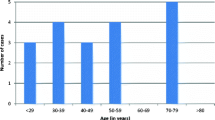Abstract
Leydig cell tumours (LCT) are rare testicular neoplasms that usually follow a benign clinical course. Due to the aggressive, difficult-to-treat nature of metastatic disease arising from a small percentage of LCTs, it is imperative to understand and recognize how to identify those tumours which exhibit features that predict malignant behaviour in order to guide initial surgical and oncological management. By using the well-described high-risk histopathological features of Leydig cell tumours as guidance, the management of LCTs has evolved to commonly include testis-sparing surgery (TSS), in patients who historically would have undergone a complete orchidectomy. Thus, assessment of the clinicopathological features of Leydig cell tumours allows for optimal management of this rare disease, whilst modern technologies and surgical techniques have altered the potential treatment landscape. This does not replace the need for the urologist and medical oncologist to remain vigilant in the risk-stratification of patients presenting with these rare testicular sex cord stromal tumours. We present three cases of patients diagnosed with Leydig cell tumours in a single institution in Dublin, Ireland, between 2016 and 2020 and discuss how the clinicopathological features dictate the management and subsequent follow-up for patients presenting with these rare tumours.







Similar content being viewed by others
Availability of Data and Material
N/A
Code Availability
N/A
References
Bertram KA, Bratloff B, Hodges GF, Davidson H. Treatment of malignant Leydig cell tumor. Cancer. 1991;68(10):2324–9. https://doi.org/10.1002/1097-0142(19911115)68:10<2324::aid-cncr2820681036>3.0.co;2-k.
Ober WB, Sciagura C. Leydig, Sertoli, and Reinke: three anatomists who were on the ball. Pathol Annu. 1981;16(Pt 1):1–13.
Al-Agha OM, Axiotis CA. An in-depth look at Leydig cell tumor of the testis. Arch Pathol Lab Med. 2007;131(2):311–7. https://doi.org/10.1043/1543-2165(2007)131[311:AILALC]2.0.CO;2.
Conkey DS, Howard GC, Grigor KM, McLaren DB, Kerr GR. Testicular sex cord-stromal tumours: the Edinburgh experience 1988-2002, and a review of the literature. Clin Oncol (R Coll Radiol). 2005;17(5):322–7. https://doi.org/10.1016/j.clon.2005.04.009.
Featherstone JM, Fernando HS, Theaker JM, Simmonds PD, Hayes MC, Mead GM. Sex cord stromal testicular tumors: a clinical series--uniformly stage I disease. J Urol. 2009;181(5):2090–6; discussion 6. https://doi.org/10.1016/j.juro.2009.01.038.
Kim I, Young RH, Scully RE. Leydig cell tumors of the testis. A clinicopathological analysis of 40 cases and review of the literature. Am J Surg Pathol. 1985;9(3):177–92. https://doi.org/10.1097/00000478-198503000-00002.
Fankhauser CD, Grogg JB, Hayoz S, Wettstein MS, Dieckmann KP, Sulser T, et al. Risk factors and treatment outcomes of 1,375 patients with testicular leydig cell tumors: analysis of published case series data. J Urol. 2020;203(5):949–56. https://doi.org/10.1097/ju.0000000000000705.
Ruf CG, Sanatgar N, Isbarn H, Ruf B, Simon J, Fankhauser CD, et al. Leydig-cell tumour of the testis: retrospective analysis of clinical and therapeutic features in 204 cases. World J Urol. 2020;38(11):2857–62. https://doi.org/10.1007/s00345-020-03079-1.
Silberstein JL, Bazzi WM, Vertosick E, Carver BS, Bosl GJ, Feldman DR, et al. Clinical outcomes of local and metastatic testicular sex cord-stromal tumors. J Urol. 2014;192(2):415–9. https://doi.org/10.1016/j.juro.2014.01.104.
Genov PP, Georgieva DP, Koleva GV, Kolev NH, Dunev VR, Stoykov BA. Management of Leydig cell tumors of the testis-a case report. Urol Case Rep. 2020;28:101064. https://doi.org/10.1016/j.eucr.2019.101064.
Osbun N, Winters B, Holt SK, Schade GR, Lin DW, Wright JL. Characteristics of patients with Sertoli and Leydig cell testis neoplasms from a national population-based registry. Clin Genitourin Cancer. 2017;15(2):e263–e6. https://doi.org/10.1016/j.clgc.2016.08.001.
Laguna MP, Albers P, Algaba F, Bokemeyer C, Boormans JL, Fischer S, et al. EAU Guidelines on Testicular Cancer 2020. European Association of Urology Guidelines. 2020 Edition. Arnhem: European Association of Urology Guidelines Office; 2020.
Giannarini G, Dieckmann KP, Albers P, Heidenreich A, Pizzocaro G. Organ-sparing surgery for adult testicular tumours: a systematic review of the literature. Eur Urol. 2010;57(5):780–90. https://doi.org/10.1016/j.eururo.2010.01.014.
Grem JL, Robins HI, Wilson KS, Gilchrist K, Trump DL. Metastatic Leydig cell tumor of the testis. Report of three cases and review of the literature. Cancer. 1986;58(9):2116–9. https://doi.org/10.1002/1097-0142(19861101)58:9<2116::aid-cncr2820580925>3.0.co;2-x.
Kollmannsberger C, Tandstad T, Bedard PL, Cohn-Cedermark G, Chung PW, Jewett MA, et al. Patterns of relapse in patients with clinical stage I testicular cancer managed with active surveillance. J Clin Oncol. 2015;33(1):51–7. https://doi.org/10.1200/jco.2014.56.2116.
Author information
Authors and Affiliations
Contributions
HC and JM conceived the idea. HC and WD gathered data and case details. HC carried out literature review. TN and MH provided histopathological details of case and images. All authors contributed to the manuscript. JM supervised the project.
Corresponding author
Ethics declarations
Consent to Participate
Yes, as per CARE guidelines, informed consent was obtained from all individual participants for whom identifying information is included in this article.
Consent to Publication
Yes, as per CARE guidelines, informed consent was obtained from all individual participants for whom identifying information is included in this article.
Conflicts of Interest
The authors declare no competing interests.
Additional information
Publisher’s Note
Springer Nature remains neutral with regard to jurisdictional claims in published maps and institutional affiliations.
This article is part of the Topical Collection on Medicine
Rights and permissions
About this article
Cite this article
Carroll, H.K., Nolis, T., Darwish, W. et al. Leydig Cell Tumours: a Case Series from a Single Irish Centre. SN Compr. Clin. Med. 3, 1307–1312 (2021). https://doi.org/10.1007/s42399-021-00841-3
Accepted:
Published:
Issue Date:
DOI: https://doi.org/10.1007/s42399-021-00841-3




